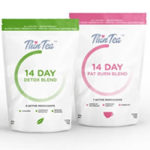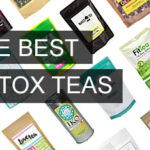What’s The Difference Between Detox Tea, Weight Loss Tea, Slimming Tea and Teatox?

Weight loss tea, detox tea, slimming tea, diet tea, fit tea, teatox…
If you’ve been looking for a tea to help promote weight loss or cleansing, chances are you’ve run across a wide array of terms.
The point of the matter is that there are a ton of different names for these teas.
Companies are pumping out detox teas at an incredible rate to try and keep up with the recent high demand.
As more companies make their own products, they come up with various terms, brands, names, labels, kinds, etc.
So we’re left with a collection of teas that all have different names.
It can definitely get a little confusing on which one is right or best for your needs.
So, is there really a difference between them all?
The truth is, there isn’t!
Detox tea, slimming tea, and weight loss tea can all be used interchangeably.
Each of these teas all have the same goals in mind, which are to help you lose weight, detox, cleanse, and promote an overall healthy body.
Obviously no 2 products will be identical but at least you know that the terms themselves are the same.
The majority of these teas will also include the same components.
Let’s look at some common inclusions in each of these teas.
Common Components in Detox Teas
Whether it’s branded as a slimming, detox, or weight loss tea, each will have at least one or a combination of the items listed below.
1. Pure Teas
Pure teas are your traditional or true teas.
All pure teas come from the same plant, which is Camellia sinensis.
Technically, a tea is not a tea unless it comes from Camellia sinensis, however we usually use the term tea to refer to a wide range of plant and floral infusions.
Just like coffee and wine, there are hundreds of different varieties of tea.
Each harvest of tea claims its own aroma, appearance, and taste.
Things such as rainfall, climate, and seasonal conditions will make each harvest slightly different from year to year.
There are 5 categories that we have for pure teas and they include: white tea, green tea, oolong tea, black tea, and pu-erh tea.
These teas are categorized by how much they’re oxidized or fermented.
Oxygen, or air, is what alters these tea leaves and gives them all unique aromas and flavors.
Here is a quick breakdown of each main type of pure tea:
- White Tea – Out of all the teas, white teas are the most un-oxidized or least processed. They have a delicate and fresh flavor like that of bamboo or asparagus and even more earthy tones such as almonds. The aroma tends to be a subtle floral scent. A popular variety of white tea is Silver Needle.
- Green Tea – Green teas are unoxidized, which leaves them with their vital color and exposes the grassy, fresh flavor of the leaf. Popular varieties of green tea are Matcha, Sencha, and Gyokuro.
- Oolong Tea – These teas are semi-oxidized and have the widest range of aromas and flavors. They can also be steeped multiple times and each time with provide a slightly different fragrance and taste. Popular varieties are Dong Ding and Tai Guan Yin.
- Black Tea – Black tea leaves are fully oxidized. They are often categorized into full leaf or broken leaf. Broken leaf tea has leaves that are purposefully broken down into smaller pieces while being processed. These teas are more brisk and have a higher amount of caffeine. Broken leaf acts as a great morning tea and pairs well with sugar and milk. Full leaf teas are more subtle and refined compared to the bolder broken leaf tea. Popular varieties are Keemun, Yunnan, and Darjeeling.
- Pu-erh Tea – This particular tea is unique because it’s actually fermented. These teas are exposed to bacteria and microflora in order to ferment the tea, such as with yogurt and wine. Pu-erh tea offers mellow and earthy flavors and is low in caffeine.
2. Herbal Teas
Herbal tea, also known as tisane, is infused with spices, herbs, and other plant material and usually doesn’t contain caffeine.
Herbal teas come in a wide variety and are usually good sources of vitamin c and antioxidants.
Examples of popular herbal tea are South African Rooibos, Peppermint, Ginger Root, Chamomile, Lemon Balm, and Rosehip.
3. Plant Based Laxatives
These plant based laxatives are meant to promote a gentle detox.
They help get you back on track if you’ve been a little off or bloated.
Laxatives also help you, in the short term, shed any excess water weight you may be carrying.
Examples of plant based laxatives are Dandelion leaf, Aloe, Rhubarb root, Catsia, Buckthorn, Burdock, and Prunella.
4. Plant Based Diuretics
These components also help aid in a gentle detox.
They increase urine output and help you shed any extra water weight in the short term.
These really help if you’ve been feeling puffy, sluggish, or bloated.
Some examples of plant based diuretics are Parsley, Hawthorn, Horsetail, Juniper, Artichoke, and Hibiscus.
5. Non-Traditional Botanical Ingredients
These ingredients are often added to detox teas to help increase weight loss.
Some have stimulant properties such as caffeine that help boost metabolism and give you additional energy.
Common natural stimulants are yerba mate, guarana seed, and ginseng.
Other ingredients included to help with weight loss are acai berry, garcinia cambogia, and cayenne pepper.
Tips While Searching For A Detox Tea
Now that you know the common components of detox, slimming, and weight loss teas, there are a few helpful tips to keep in mind while searching.
For these teas, the purer the better.
The whole point of a detox is to cleanse, heal, and promote an overall healthy body.
This means that your detox tea should be free of chemicals, preservatives, additives, or anything artificial.
Teas in their natural form are the healthiest and offer the most benefits, so there’s no need to tamper with that and add in meaningless “junk”.
Also, stay away from harsh laxatives such as senna leaf.
A gentle detox is completely fine but strong laxatives, especially used for longer periods of time are not healthy for the body.
Find a tea that is most convenient for you to use.
Some teas are loose leaf, packaged, or in pods.
We have found that the individually packaged tea with a string attached is the most useful, clean, and easiest way to use them.
Remember that these are NOT liquid diets.
Do not take a detox tea if it suggests you shouldn’t eat.
These teas are meant to be part of a healthy, balanced diet (which requires actual meals!)
Keep an eye out for satisfaction guarantees, as well, when you’re shopping.
In Conclusion
Now you know that weight loss, slimming, and detox teas are all the same, regardless of what companies may say.
The goal is to help you lose weight, cleanse, detox, and look and feel better.
Each contains a combination of pure teas, herbal teas, plant based laxatives/ diuretics, and botanical ingredients.
Keep those tips in mind when searching for a detox tea.
If you need help finding just the right detox tea, check out our list of the top 10 best detox teas!










